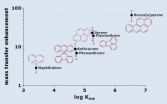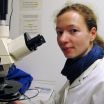(Press-News.org) You must use a microscope to spot the new helpers that can assist in biological soil clean-up (bioremediation). They are small, mobile microorganisms, such as the unicellular slipper-shaped ciliates that can be found in stale water in a flower vase, where they feed on bacteria. New results from Aarhus University indicate that such mobile microorganisms can play a surprising key role in bioremediation of soil which is contaminated with so-called PAHs (Polycyclic Aromatic Hydrocarbons).
PAH are toxic tar substances formed during incomplete combustion in, for example, car engines and cigarettes. The classic PAH is benzo(a)pyrene, which was one of the first substances shown to be able to cause cancer. Until now PAHs were considered minimally mobile in soil because they bind to soil particles and only small amounts of PAH can be dissolved in water. However, the new study reveals that motile microorganisms can increase the mobility of PAHs significantly.
The experiments show that ciliates can enhance the transport of PAHs and potentially other hydrophobic chemicals up to 100-fold. This can be of great importance for the mobility and bioavailability of such substances and opens up new perspectives for cleaning PAH-contaminated soil because bioavailability is a crucial prerequisite for the biodegradation of PAHs.
First time ever
PhD student Dorothea Gilbert has been responsible for the tests with the ciliate Tetrahymena pyriformis. Together with Professor Philipp Mayer, who is presently employed at the Technical University of Denmark (DTU), she has developed a new test setup that allows exposing the ciliates to a concentration gradient while concurrently enabling their observation through a microscope in real time and measuring the transport of PAH by means of chromatographic methods.
"Until now, no one has ever It has to our knowledge not been shown before that microorganisms can actively move PAHs. Previously, we have seen that such substances can be transported passively with the water flow when they are bound to small particles, colloids or bacteria. Our experiments demonstrate that motile microorganisms such as Tetrahymena pyriformis swim actively with the PAHs, and it is important to notice that the ciliates can swim faster than PAHs can be transported by means of diffusion. This makes them very effective shuttles for PAHs on small spatial scale where there is no fluid flow.
Looking at several PAHs simultaneously, we observed that the mass transfer enhancement increased with the hydrophobicity of the PAHs. This is connected with the fact that more PAH is incorporated into the ciliates' lipid cell membrane, the more hydrophobic the PAHs" says Dorothea Gilbert.
New perspectives for soil bioremediation
These results question whether PAHs are quite as immobile in soil as has been thought until now.
"We expect that mobile microorganisms can transport PAHs in the stagnant water around and between soil particles and in water-filled pores. On such a micro-scale transport is generally based on diffusion, which for PAHs is very limited. Our study shows that mobile microorganisms can in such diffusion-limited condition increase the transport of PAHs. Our discovery can also be important with regard to bioremediation of PAH-contaminated soil.
The new findings indicate that microorganisms can increase the mobility of PAHs. By this means PAHs may become more accessible to bacteria which can degrade them, and make them more accessible to plant roots that can absorb them. Both are important prerequisites for biological treatment of PAH-contaminated soil," explains Dorothea Gilbert.
The findings have been published in the scientific journal Environmental Science & Technology.
INFORMATION:
Further information
PhD student Dorothea Gilbert, Department of Environmental Science, Aarhus University and DTU, tel. +45 8715 8614, dgi@dmu.dk
Co-transport of polycyclic aromatic hydrocarbons by mobile microorganisms leads two enhanced mass transfers under diffusive conditions. 2014. Dorothea Gilbert, Hans H. Jakobsen, Anne Winding and Philipp Mayer. Environmental Science & Technology. DOI: 10.1021 /ES404793U
Link: http://pubs.acs.org/doi/abs/10.1021/es404793u
Video
Here is the documentation that proves that the ciliates, Tetrahymena pyriformis, can move PAH. See how the ciliates move from areas with a high concentration of PAH to areas with a low concentration. When the ciliates have absorbed PAH, they become stained in the flourescence microscope.
http://youtu.be/LeuOyBMY_YA
New perspective for soil clean-up: Microscopic ciliates transport poisonous tar substances
2014-03-24
ELSE PRESS RELEASES FROM THIS DATE:
New technique for identifying gene-enhancers
2014-03-24
An international team led by researchers with the Lawrence Berkeley National Laboratory (Berkeley Lab) has developed a new technique for identifying gene enhancers - sequences of DNA that act to amplify the expression of a specific gene – in the genomes of humans and other mammals. Called SIF-seq, for site-specific integration fluorescence-activated cell sorting followed by sequencing, this new technique complements existing genomic tools, such as ChIP-seq (chromatin immunoprecipitation followed by sequencing), and offers some additional benefits.
"While ChIP-seq is very ...
Smokers' bitter taste buds may be on the fritz
2014-03-24
Smokers and those who have quit cannot fully appreciate the full flavor of a cup of coffee, because many cannot taste the bitterness of their regular caffeine kick. This is the finding of a study led by Nelly Jacob of the Pitié-Salpêtrière Hospital APHP in France, published in Springer's journal Chemosensory Perception.
It is already known that smoking, and especially the toxic chemicals in tobacco, causes a loss of taste among smokers. It also causes structural changes to the fungiform papillae of the tongue where the taste buds are located. However, it is not yet known ...
A mathematical equation that explains the behavior of nanofoams
2014-03-24
This news release is available in Spanish.
A research study, participated in by Universidad Carlos III de Madrid (UC3M), has discovered that nanometric-size foam structures follow the same universal laws as does soap lather: small bubbles disappear in favor of the larger ones.
The scientific team, made up of researchers from the Consejo Superior de Investigaciones Científicas (Spanish National Research Council) - CSIC, the Universidad Pontificia Comillas de Madrid- UPCO, and UC3M, reached this conclusion after producing and characterizing nanofoam formed by ion ...
Plugging the hole in Hawking's black hole theory
2014-03-24
EAST LANSING, Mich. --- Recently physicists have been poking holes again in Stephen Hawking's black hole theory – including Hawking himself. For decades physicists across the globe have been trying to figure out the mysteries of black holes – those fascinating monstrous entities that have such intense gravitational pull that nothing – not even light – can escape from them. Now Professor Chris Adami, Michigan State University, has jumped into the fray.
The debate about the behavior of black holes, which has been ongoing since 1975, was reignited when Hawking posted a ...
Patient enrollment, use, and satisfaction with patient portals
2014-03-24
Many physicians are adopting patient portals in response to governmental incentives for meaningful use (MU), but the stage 2 requirements for portal use may be particularly challenging for newer electronic health record (EHR) users. This study examines enrollment, use based on MU requirements, and satisfaction in a recently-adopting fee-for-service multispecialty system. The Centers for Medicare and Medicaid Services (CMS) financial incentives for meaningful use (MU)1 likely will persuade many reluctant doctors to adopt electronic health records (EHRs). However, there are ...
Research finds moving public assistance payments from cash to plastic cuts crime
2014-03-24
ATLANTA--Counties that change their delivery of public assistance benefits from paper checks to an Electronic Benefit Transfer (EBT) system – using debit cards – see their street crimes drop significantly, according to a study published today by the National Bureau of Economic Research.
Titled "Less Cash, Less Crime: Evidence from the Electronic Benefit Transfer Program," the study is the first to empirically examine whether the introduction of an EBT system, which reduces the amount of cash circulated on the streets, will disrupt criminal activities that rely on the ...
First look at breast microbiota raises tantalizing questions
2014-03-24
The female breast contains a unique population of microbes relative to the rest of the body, according to the first-ever study of the breast microbiome. That study sought to lay the groundwork for understanding how this bacterial community contributes to health and disease, says first author Camilla Urbaniak, a PhD student at the University of Western Ontario. The research was published ahead of print in Applied and Environmental Microbiology.
"Proteobacteria was the dominant phylum in healthy breast tissue," says Urbaniak, noting that it is found only in small proportions ...
Prostate treatment lasts, preserves fertility
2014-03-24
SAN DIEGO (March 24, 2014)—Shrinking the prostate without surgery can provide long-term relief to men with this common condition that causes annoying symptoms, such as frequent trips to the bathroom, suggests a study of nearly 500 men. According to research being presented at the Society of Interventional Radiology's 39th Annual Scientific Meeting, 72 percent of men experienced symptom improvement three years after having a new, minimally invasive, image-guided treatment performed by interventional radiologists called prostate artery embolization (PAE).
"The results of ...
New implant shows promise for painful osteoporotic spine fractures
2014-03-24
SAN DIEGO (March 24, 2014)—Individuals suffering from spinal fractures—caused by osteoporosis or weakened bones—now have another option to reduce pain, restore function and improve quality of life, according to a study of 300 patients treated with a new type of vertebral augmentation. Results of a randomized, controlled multicenter trial on a new implant treatment for vertebral compression fractures are being reported for the first time at the Society of Interventional Radiology's 39th Annual Scientific Meeting.
Made of medical polymer, the implant is designed to treat ...
Keep calm and don your video glasses
2014-03-24
SAN DIEGO (March 24, 2014)—Music may soothe the soul, but it takes video to calm a patient undergoing medical treatment, notes a study in which individuals watched television shows or movies through special video glasses while having a biopsy or other minimally invasive treatment. The research is being presented at the Society of Interventional Radiology's 39th Annual Scientific Meeting.
Although interventional radiology treatments offer less risk, less pain and less recovery time compared to open surgery, patients nonetheless may be anxious about them and their outcomes. ...




